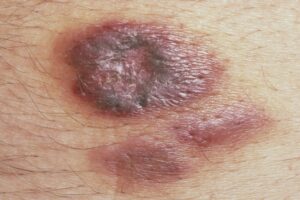Sarcoma is a type of cancer that affects the bones and soft tissues in the body such as muscles, cartilage, and nerves. There are many different subtypes of sarcoma, but the most common types are osteosarcoma (bone cancer), chondrosarcoma (cartilage cancer), and synovial sarcoma (soft tissue cancer). Sarcoma is a relatively rare type of cancer, accounting for only about 1% of all cancers. However, it is a serious and potentially life-threatening condition that requires prompt diagnosis and treatment.
Symptoms of Sarcoma
The symptoms of sarcoma can vary depending on the type and location of the cancer. However, some common symptoms of sarcoma include:
Pain: Pain is a common symptom of sarcoma, especially in the affected bone or soft tissue. The pain may be constant or intermittent and may become more intense over time.
Swelling: Swelling in the affected area may be a sign of sarcoma. The swelling may be accompanied by pain or may be painless.
Limitation of movement: If the sarcoma is affecting a joint, it may cause stiffness or limited movement in that joint.
Fracture: Sarcoma that affects bones can cause a fracture, even without significant injury.
Fatigue: Fatigue is a common symptom of sarcoma and can be caused by the cancer itself or by the treatments used to treat it.
Diagnosis of Sarcoma
Diagnosing sarcoma usually involves a combination of tests, including:
Physical examination: Your doctor will examine the affected area and look for any signs of sarcoma, such as swelling, pain, or limited movement.
Imaging tests: Imaging tests, such as X-rays, CT scans, MRI scans, and PET scans, can help diagnose sarcoma. These tests can also help your doctor determine the size and location of the tumor and whether it has spread to other parts of the body.
Biopsy: A biopsy is a procedure in which a small sample of tissue is removed from the affected area and examined under a microscope to determine if it is cancerous.
Treatment of Sarcoma
The treatment of sarcoma depends on several factors, including the type and stage of the cancer, the patient’s overall health, and the patient’s personal preferences. Common treatments for sarcoma include:
Surgery: Surgery is often the first line of treatment for sarcoma. The goal of surgery is to remove the entire tumor, along with a margin of healthy tissue, to ensure that all of the cancer cells have been removed. In some cases, reconstructive surgery may also be necessary to restore function to the affected area.
Radiation therapy: Radiation therapy uses high-energy beams of radiation to kill cancer cells. Radiation therapy can be used before or after surgery to shrink the tumor or to kill any remaining cancer cells after surgery.
Chemotherapy: Chemotherapy is a treatment that uses drugs to kill cancer cells. Chemotherapy can be used before or after surgery to shrink the tumor or to kill any remaining cancer cells after surgery.
Targeted therapy: Targeted therapy is a type of treatment that targets specific genes or proteins in cancer cells. Targeted therapy can be used in combination with other treatments to improve the effectiveness of the treatment.
Immunotherapy: Immunotherapy is a type of treatment that uses the body’s own immune system to fight cancer. Immunotherapy can be used in combination with other treatments to improve the effectiveness of the treatment.

 Home
Home Health
Health Diet & Nutrition
Diet & Nutrition Living Well
Living Well More
More












